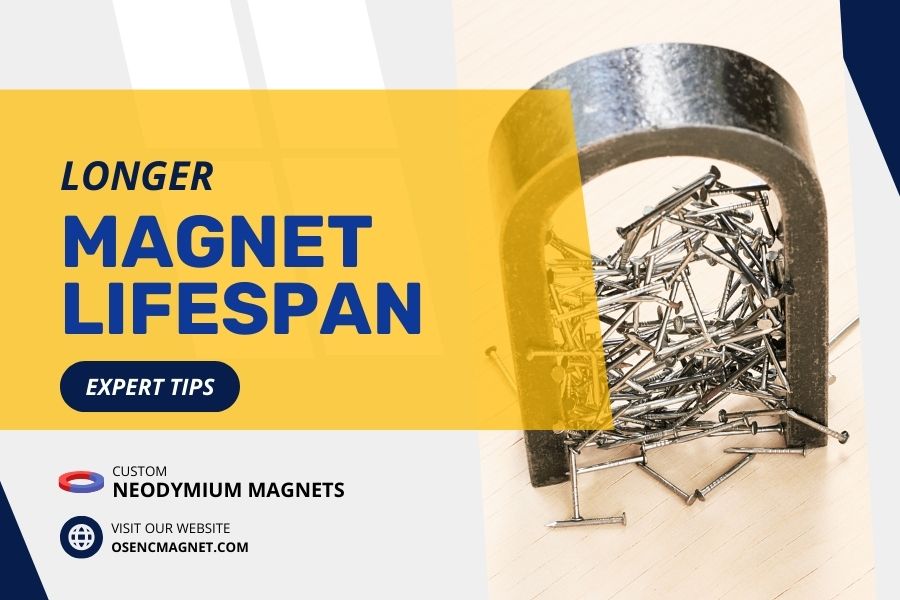This post lists the fundamentals of common surface treatments for neodymium magnets.
It will help you pick the right surface finish from a neodymium magnet supplier.
- Choose right and your neodymium magnets will perform well for decades.
- Choose wrong and their magnetism can rapidly weaken, making them useless.
Use this guide to pick the ideal surface treatment for your custom neodymium magnets.
Why Surface Treatments?
Neodymium magnets require surface treatment and coatings for several important reasons:
Corrosion Protection
Neodymium magnets contain iron.
- This property makes them prone to corrosion and oxidation in moisture or humid environments.
- Even the moisture in the air can cause uncoated neodymium magnets to corrode over time.
- As a result, corrosion leads to weakening and crumbling of the magnet.
Brittleness
Neodymium magnets are extremely hard but also very brittle.
- Surface coatings like nickel, copper, and epoxy resin help improve the durability and resistance to chipping and wear.
- This is especially true around the corners and edges.
Environmental Protection
Certain environments like coastal regions with salty air, or exposure to harsh chemicals, require specialized coatings.
Common coatings
Nickel-Copper-Nickel (NiCuNi): Provides excellent humidity, heat, and salt spray resistance for conventional environments.
Epoxy: Offers excellent humidity resistance, adhesion, heat, and salt spray resistance.
Zinc: Provides good salt spray resistance.
Everlube: Excellent resistance to heat, viscous properties, and suitable for auto parts.
Black Nickel, Tin, Gold, Silver: Offer good corrosion resistance and aesthetic appeal.
Factors for Surface Treatment
When choosing the right surface treatment or coating for neodymium (NdFeB) magnets, there are several key factors to consider:
Operating Environment
Corrosion Resistance
The operating environment plays a crucial role in determining the required level of corrosion resistance. Environments with high humidity, saltwater exposure, or chemical exposure necessitate coatings with excellent corrosion resistance, such as nickel-copper-nickel (NiCuNi), epoxy, or parylene.
Temperature Range
Some coatings perform better than others at extreme temperatures. For high-temperature applications, coatings like Teflon, Everlube, or ceramic coatings may be more suitable, while epoxy or parylene coatings are better for low-temperature environments.
Mechanical Requirements
Wear and Abrasion Resistance
Applications involving frequent contact or friction may require coatings with high wear and abrasion resistance, such as Teflon, Everlube, or hard anodized coatings.
Impact Resistance: For applications where the magnets may be subject to impact or shock, coatings like epoxy, plastic, or rubber coatings can provide additional protection against chipping or cracking.
Aesthetic & Functional Requirements
Appearance
If the appearance of the magnet is important, coatings like nickel, gold, or colored epoxy can provide an attractive finish.
Electrical Conductivity
For applications requiring electrical conductivity, coatings like gold, silver, or nickel may be preferred over insulating coatings like epoxy or Teflon.
Biocompatibility
In medical or food-related applications, biocompatible coatings like parylene, gold, or silver may be required to meet regulatory standards.
Cost & Performance Considerations
Budget
Different coatings have varying costs, with some being more expensive than others. Nickel, zinc, and epoxy coatings are generally more cost-effective, while gold, parylene, and Teflon coatings are more expensive.
Magnetic Performance
Some coatings, particularly thicker ones like plastic or rubber, can slightly reduce the magnetic strength of the magnet. This may be a consideration for applications requiring maximum magnetic performance.
Inspecting Coating Quality
Here is a brief introduction about how we can inspect the quality of the coating or plating layer on neodymium magnets to verify its integrity:
- Visual Inspection – Check the coating with your eyes under natural light, or under a fluorescent lamp with an illumination equivalent to 40W for defects like bubbles, peeling, uneven coverage, discoloration, stains, etc.
- Thickness Testing – Measure the coating thickness to ensure it meets specifications.
- Drop Testing – Drop magnets to check coating durability (Mainly for zinc coatings).
- Cross-Cut Testing – Checks adhesion by cutting into the coating (Typically for nickel coatings).
- Thermal Shock Testing – Cycles magnets between extreme temperatures to test coating endurance.
- Pressure Testing – Applies high pressure to simulate real-world conditions.
- Salt Spray Testing – Exposes magnets to a salt fog environment to validate corrosion resistance.
- Humidity Testing – Prolonged exposure to high humidity verifies coating performance.
Coatings and Magnetic Strength
Any separation between the actual magnet and the object in front of it results in a reduction of the magnet’s strength.
This is particularly evident when non-metal coatings like rubber or plastic are preferred.
Unlike metal coatings such as nickel, which help transmit the magnetic field, rubber and plastic maintain a degree of separation between the magnetic field and the target object.
So, how much strength is lost due to coating?
To calculate the strength loss, the inverse square law can be applied, which states that the force of a magnet is inversely proportional to the square of the distance from the source.
In simpler terms, the strength of a magnet diminishes rapidly, even with slight increases in distance.
In an in-house study, we measured a magnet’s force from 1 millimeter away and then repeated the measurement from 2 millimeters away.
We found that this small increase in distance resulted in a fourfold reduction in the magnet’s strength.
Another way to grasp this concept is to consider that when you are in direct contact with a magnet, you experience 100% of its force.
However, when you move just two inches away, the magnet’s strength drops to 10%. Clearly, proximity plays a crucial role.
What should you look for in a coating?
When maintaining maximum strength is a priority, opting for a metal-based coating, such as nickel, is advisable. However, larger magnets may require multiple layers of coatings for physical protection, often including an inner nickel layer, followed by a copper layer, and then an outer nickel layer.
Keep in mind that these additional layers introduce some distance from the magnet, resulting in a slight reduction in overall strength.
If you require a waterproof, non-slip, or colorful coating, plastic or rubber coatings are suitable. However, the challenge lies in the consistent separation between the magnet and surrounding objects. When using plastic or rubber coatings, you might need to employ a larger magnet than usual to compensate for the strength lost due to the coating.
Conclusion
What Do You Think?
Now I’d like to turn things over to you:
- Which surface treatment from this list was best for you?
- Or maybe you have some ideas that I didn’t cover here.
Either way, let me know and fill the contact form below.



